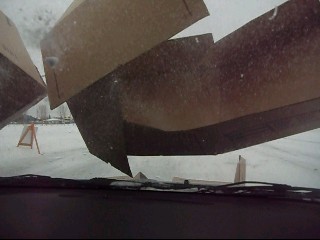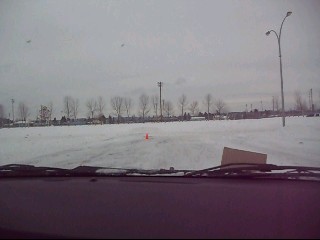'Crash' Course In Road Conditions

The view as I hit the 'pedestrian' during my test drive with the RCMP and ICBC
Prince George, B.C. - I was traveling 50-km/hr when Prince George RCMP Sergeant Al Steinhauser told me to stop -- he was my 'mind's eye' telling me to stop for the pedestrian who had just stepped onto the street...
When I continued to slide on the compact snow and ice in the parking lot at CN Centre and plowed into the 'pedestrian' with a sickening thud, my stomach clenched and my hands started to shake. Sergeant Steinhauser helpfully pointed out that I had dragged my 'pedestrian' on the front grill of the passenger's side as I skidded to a halt.
Fortunately, the 'pedestrian' I hit was only a now-demolished cardboard box.
 Clicking on the photo at right will show video footage of my test drive. Just after Sergeant Steinhauser tells me to brake you can see a 30km sign on the left-hand sign, that's where a vehicle traveling at that slower speed stopped on a previous test run. The pilon you can see out the front windshield after I've come to a stop is where the vehicle traveling at 70-km/hr finally came to rest -- it's a full 90-metres further down the course.
Clicking on the photo at right will show video footage of my test drive. Just after Sergeant Steinhauser tells me to brake you can see a 30km sign on the left-hand sign, that's where a vehicle traveling at that slower speed stopped on a previous test run. The pilon you can see out the front windshield after I've come to a stop is where the vehicle traveling at 70-km/hr finally came to rest -- it's a full 90-metres further down the course.
The vehicle I was driving was equipped with an anti-locking brake system, meaning my tires kept turning to give me traction. I could have tried to maneuver around the hazard, but Sergeant Steinhauser pointed out that's often not possible when driving on a busy four-lane street.
The RCMP and ICBC teamed up to give local media this opportunity to try out stopping distances in adverse weather conditions because driving too fast for road conditions is an issue every year, but it's been particularly devastating this past week in the north. (click here for previous story)
ICBC Road Safety Coordinator, Diana Pozer, said in the Northcentral region, the number of casualty crashes due to driving too fast for conditions doubles in December compared to October -- there are approximately 53 crashes in December, as compared to approximately 28 in October.
Prince George Regional Traffic Services Unit NCO, Sergeant Pat McTiernan said it's imperative for motorists to determine whether their vehicle is equipped with ABS or not, and whether there are any other limitations in their car. "What this exercise shows us is that if you slow down and drive to the conditions out there, that you're going to be able to stop for the hazards that present themselves on the road."
"Once the weather starts to deteriorate, it's up to the motorists to adjust their speed accordingly," he said. The charge for driving too fast for road conditions carries a $167 fine and points. Sergeant McTiernan said people often say they were driving the posted limit, but he said police have little difficulty proving the charge in court by documenting the road conditions. "And I think we showed today (Thursday) that when you start taking an extra 90-metres to stop, if you go out on the highway and you're driving 120, instead of 100, you can see where those distances are just going to take off."
Since my test drive, I've thought about what raced through my mind when I knew I was going to hit the boxes -- there was no avoiding them and the vehicle wasn't stopping -- and I'm just oh so thankful they were only boxes.
Previous Story - Next Story
Return to Home









Myself I am not very impressed with antilock brakes. Has anyone else noticed when coming to a stop when the antilocks cut in the car just seems to keep on going. Yes I know the road is slippery that is why they cut in, but I am coming to a nice even stop before they cut in, and then when they do the car goes on and on before stopping.
I did an experiment on parking lot and found when I pumped the brakes on the same conditions I stopped in a shorter distance.